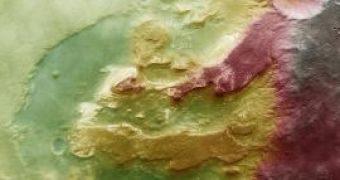Back on 13 April 2007, during its 4199 orbit around the Red Planet, ESA's Mars Express took an image of the Terby crater, with the help of its High Resolution Stereo Camera. It seems to be presenting high scientific interest, mainly because it could hold valuable information about the role of liquid water in the planet's geology. Terby crater is located in the southern Martian Hemisphere, near the edge of the Hellas Planitia impact basin.
It was named after the Belgian astronomer Francois J. Terby, has a diameter of about 170 kilometer and seems to present finger-shaped plateaus extending in a north-south general direction, rising more than 2000 meters above the bed of the crater, evidence than it was filled in the past with sediment deposits which have been eroded over time. You can see in the image how the Sun illuminates the surface of Mars from the west, which is figured upwards in the photograph. Also in the north end of the crater the partial image of a second impact remnant can be seen.
On the sides of each finger-shaped plateaus, different colored materials can be observed, which usually indicates a change in the composition of the sediments that have been deposited in layers and eroded over time by the action of liquid water or wind. Because different rock types have different hardness, they erode at different rates and form terraces.
The first evidence of past presence of running liquid water of the surface of the Red Planet in Terby Crater can be observed in so-called gullies or channels, mostly dominant in the norther part of the crater. Such cutting action can only be associated to ground running liquids. These key features make Terby crater an ideal candidate for future study, being one of the 33 possible locations for the landing spots for the next mission planned to Mars, the Mars Science Laboratory mission which is scheduled to launch by 2009.
The colors of the crater were calculated digitally by deriving the colors from the three channels observable in the image and the lowest part of the crater, and filtered through the stereoscopic channels of the HRSC camera, in order to create a three-dimensional image, meaning it requires stereoscopic glasses to be viewed properly.

 14 DAY TRIAL //
14 DAY TRIAL //